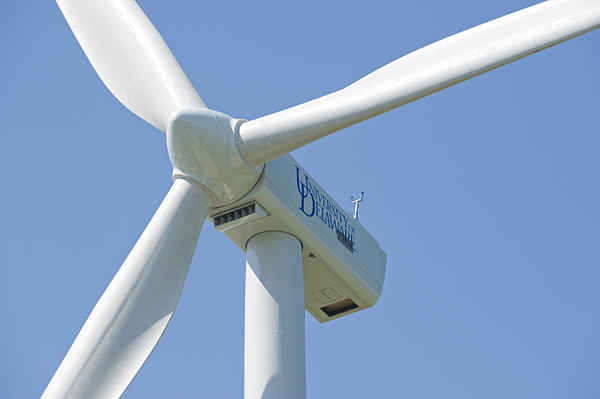
Tower of power
Turbine generated research funds, energy for UD and community in first year
1:17 p.m., June 24, 2011--The University of Delaware’s wind turbine produced 5.1 million kilowatt hours (kwh) of energy during its first year of operation, experts told seminar attendees at UD’s Hugh R. Sharp Campus in Lewes yesterday. That was enough to power UD’s Lewes campus, with a surplus of 1.3 million kwh — sufficient for about 120 homes — sent to the Lewes Board of Public Works for use by the city’s homeowners.
The energy production took place between June 11, 2010, and May 31, 2011, and was about what UD and turbine manufacturer Gamesa had estimated pre-construction. UD and Gamesa put the vast majority of revenues from production of the green energy back into wind energy research, with some funds going to pay back UD’s share of capital costs.
Campus Stories
From graduates, faculty
Doctoral hooding
Also expected by those involved with the project was the fact that the turbine generated more power in the winter months than in the summer. UD remains connected with the Lewes Board of Public Works so it can receive power during the times when the turbine isn’t generating enough power to supply the whole campus.
“September through May the turbine was generating enough or more than we consume (at UD), and those were the months when we were sending power to all of you,” Jeremy Firestone, professor in UD’s School of Marine Science and Policy, told the crowd of about 100.
In addition to energy production, the turbine serves as a platform for research, project organizers said. Examples include an avian and bat study that looks at its impact on area birds and bats, corrosion research investigating how the salty coastal air affects the machine, and a project investigating wear and tear on its drive train. Students are also taking advantage of the educational and research opportunities afforded by the turbine.
The turbine is probably the most coastally placed wind turbine in the mid-Atlantic, making it ideal for studies that can inform the wind industry, the presenters said.
“We have an advisory board that includes industry wind turbine designers,” UD’s Willett Kempton explained. “Their judgment is that this is valuable work that goes beyond what you would do in designing a machine where you have a certain timeframe and a production schedule.”
Presenters also explained the results of a December 2010 sound study completed by consultant Tech Environmental. The analysis showed the turbine to be under Delaware limits for background and ambient noise. The turbine was 14 to 20 decibels below state standards during the day and 10 to 13 decibels below at night. As the decibel scale is logarithmic, for every 10 decibels below standards that sound is only half as loud.
While operational during the study period, the sound from turbine was measured at 40 to 45 decibels. For comparison, a jet at 300 meters would be 105 decibels; a diesel truck at 60 miles per hour would be 85 decibels; and the sound of a kitchen dishwasher from a standard living room is about 50 decibels.
See the study’s complete results.
In addition to the crowd being very supportive of the project — several attendees spoke up about their approval — they were very curious about wind energy and easily took up 40 minutes of question-and-answer time. Several inquired about future plans for turbines in the region. UD has no plans whatsoever to install another land-based turbine on its Lewes campus, said College of Earth, Ocean, and Environment Dean Nancy Targett.
“We at the University of Delaware are not looking for any further land-based turbines,” she said. “We have had an interest in exploring offshore turbines and looking at the offshore environment as a test platform.”
Other questions from the audience targeted ways to smooth out fluctuations in energy produced by the turbine, safety features for times of exceptionally high wind speeds, and investigations about residents’ underlying values and beliefs about wind energy. In response to another question about future steps, Firestone reinforced the idea that UD’s focus is on the offshore environment.
“We learned a lot from the land turbine. We think it’s important as well for Delawareans to see a real utility-scale turbine and get some experience,” he said. “We got some experience, but we really do want to look offshore.”
The night ended with one of the supporters speaking up. Hazel Brittingham said she calls the turbine “Grace” because it is so graceful but also because in 1919 her in-laws purchased 245 acres of land and started Lewes Dairy, which sits adjacent to the campus. She believes the turbine is located on part of that land, and her in-law’s name was Grace.
“So I can check on Grace from all angles, and I just love it,” she said.
Get more background on the turbine and see slides from this presentation.
About the presenters
Jeremy Firestone is professor of marine policy and director of UD’s Center for Carbon-free Power Integration. Willett Kempton is professor of marine policy. Nancy Targett is dean of the College of Earth, Ocean, and Environment and director of the Delaware Sea Grant College Program. Firestone, Kempton, and Targett led the development of the UD turbine. Also presenting was Miguel-Angel Gonzalez-Posada, Gamesa USA vice president for technology.
Article by Elizabeth Boyle
Photo by Evan Krape








